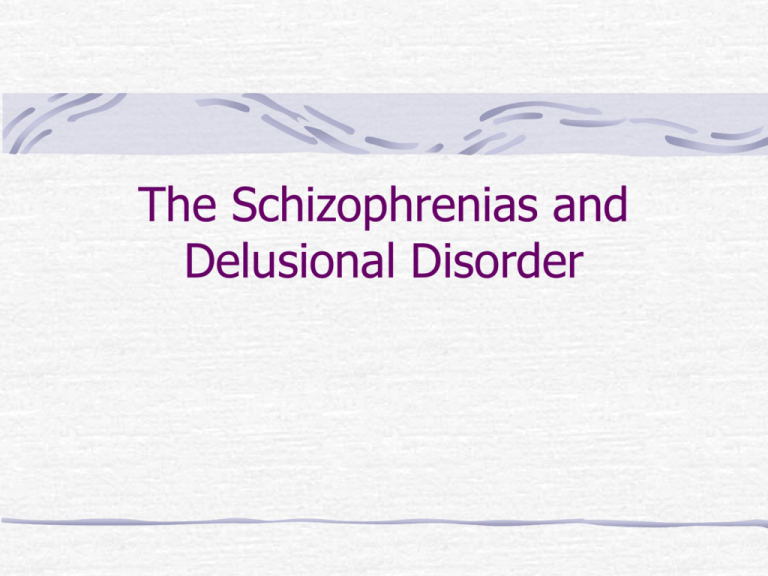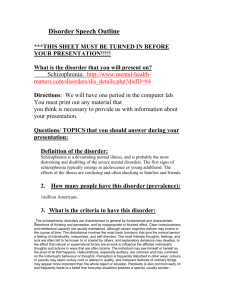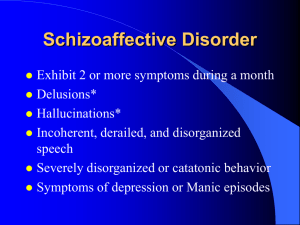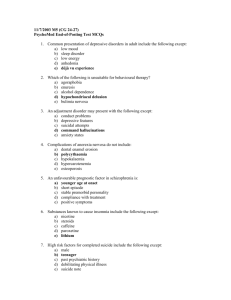The Schizophrenias and Delusional Disorder
advertisement

The Schizophrenias and Delusional Disorder Schizophrenias mental disorders characterized by the breakdown of integrated persoanolity functioning, withdrawal from reality, emotional blunting and distortion, and disturbances in thought and behavior. Psychosis- a significant loss of contact with reality, as when hallucinations or delusions are present. Delusional Disorder a paranoid disorder in which a person nurtures, gives voice to, and sometimes takes action on beliefs that are considered completely false and absurd by others. Entrance into a delusional system. Brief Psychotic Disorder The Schizophrenias Origins go back to Benedict Morel Demence Precoce (mental deterioration at early age) Adopted by Kraeplin Term is misleading however, as there is no compelling evidence of progressive brain degeneration in the natural course of the disorder In 1911 Eugen Bleuler termed these disorders “schizophrenia” (split mind). A disorganization of thought processes: Split between the intellect and emotion Split between the intellect and external reality Split Mind: Prevalence & Onset Difficult to assess based on cultural beliefs (can you think of some in local cultures?) Lifetime prevalence (0.7) During any given year in the U.S. 1% meet criteria (over 2 million) Diagnosis in 40% of all state hospital admissions No gender differences in prevalence Split Mind: Prevalence & Onset Three fourths of onsets occur between the ages of 15 and 45 with a median age in the mid 20s Males have earlier onset (early 20s) Females have later onset (late 20s) Based on brain imaging studies it appears that males develop more severe forms of these disorders Onset The Clinical Picture in Schizophrenia (see next slide) Positive-syndrome Negative-syndrome Type I schizophrenia Type II schizophrenia Type I & II Association to Pos & Neg Positive Syndrome Negative Syndrome Hallucinations Delusions Derailment of Assoc. Bizarre Behavior Min. Cog Impairment Sudden Onset Variable Course Emotional Flattening Poverty of Speech Asociality Apathy Sig. Cog Impairment Insidious Onset Chronic Course TYPE I.-------------------The above plus Type II.------------------Plus Good Med Response Limbic System Abnormality Normal Brain Ventricles Uncertain Med Response Frontal Lobe Abnormality Enlarged Brain Ventricles The Clinical Picture in Schizophrenia Disturbances of associative thinking Cognitive Slippage or Loosening of Associations Disturbances of thought content Delusions (false beliefs; thoughts controlled by others) Disruption of perception Hallucinations (auditory, olfactory, visual, etc.) Unable to sort out and process sensory information Emotional dysfunction Anhedonia (inability to experience joy) Blunting The Clinical Picture in Schizophrenia Confused sense of self Disrupted volition Disruption in goal directed behavior Retreat to an inner world Rejection of external world Loosened ties to external world Disturbed motor behavior Psychomotor agitation and retardation & other peculiarities of movement Schizophrenia DSM-IV Criteria A. Characteristic Symptoms (2 or more during a 1 month period) Delusions Hallucinations Disorganized Speech Grossly disorganized or catatonic behavior Negative symptoms B. Social/Occupational Dysfunction C. Duration D. Schizoaffective and Mood Disorder Exclusions E. Substance/General Medical Condition Exclusion F. Relationship to a Pervasive Developmental Dis. The Classic Subtypes Undifferentiated (waste basket) Catatonic (pronounced motor signs both extreme stupor and excitement) Disorganized (earlier more severe disintegration of the personality) Paranoid (person becomes centered on themes of suspiciousness, persecution, and/or grandeur) Schizophrenia Residual (considerable recovery with mild signs of past disorder) Split Mind: Causal Factors I Biological Factors Genetic studies demonstrate heritablility Adoption studies demonstrate moderate genetic effect (heritability) Biochemical factors appear to include dopamine Neurophysiological factors Cognitive dysmetria and smooth pursuit eye movement Neuroanatomical factors Brain mass anomalies include enlargement of ventricles and sulci are noted Onset Split Mind: Causal Factors II Psychosocial Factors Damaging Parent-Child and Family Interactions Popular view in the 1950’s Faulty communication and the double blind Sociocultural Factors Less common in less “well-developed” countries In U.S. lower socioeconomic status is associated with a higher prevalence Treatments and Outcomes Antipsychotic Medication Psychosocial Approaches Family Therapy (focus on expressed emotion) Individual Psychotherapy (coping skills and personal management) Social-Skills Training Outcome studies demonstrate around 40% social recoveries with medication use in conjunction with other treatment Delusional Disorder I Individual feels singled out and taken advantage of, mistreated, plotted against, stolen from, spied on, ignored or otherwise mistreated Hold a delusional system usually centered on one theme Aside from delusional system such individuals may appear perfectly normal in conversation, emotionality, and conduct Delusional Disorder A. Nonbizarre delusions (i.e., involving situations that occur in real life, such as being followed, poisoned, loved at a distance, or deceived by spouse or lover, or having a disease) of at least 1 month's duration. B. Criterion A for Schizophrenia has never been met. Note: Tactile and olfactory hallucinations may be present if they are related to the delusional theme. C. Apart from the impact of the delusion(s) or its ramifications, functioning is not markedly impaired and behavior is not obviously odd or bizarre. D. If mood episodes have occurred concurrently with delusions, their total duration has been brief relative to the duration of the delusional periods. E. The disturbance is not due to the direct physiological effects of a substance (drug abuse, medication or a medical condition) Delusional Disorder Types (based on theme) Persecutory (they are being subjected to spying, stalking, rumors)** most common of the types. Jealous (sexual partner is being unfaithful) Erotomanic (a high status person wants to start a sexual liaison with them) Somatic (belief of having some physical illness or disorder whose nature is delusionally absurd) Grandiose (person has extrordinary status, power, ability, talent, beauty, etc.) Mixed (combinations of the above themes) Delusional Disorder II Causal Factors and Treatment Poorly understood Delusional Disorder: Causal Factors Brief Psychotic Disorder 1) Presence of one (or more) of the following symptoms: delusions hallucinations disorganized speech (e.g., frequent derailment or incoherence) grossly disorganized or catatonic behavior Note: Do not include a symptom if it is a culturally sanctioned response pattern. 2) Duration of an episode of the disturbance is at least 1 day but less than 1 month, with eventual full return to premorbid level of fx. 3) The disturbance is not better accounted for by a Mood Disorder With Psychotic Features, Schizoaffective Disorder, or Schizophrenia and is not due to the direct physiological effects of a substance (e.g., a drug of abuse, a medication) or a general medical condition. Specify if: with Marked Stressor, without Marked Stressor, or Postpartum onset.








